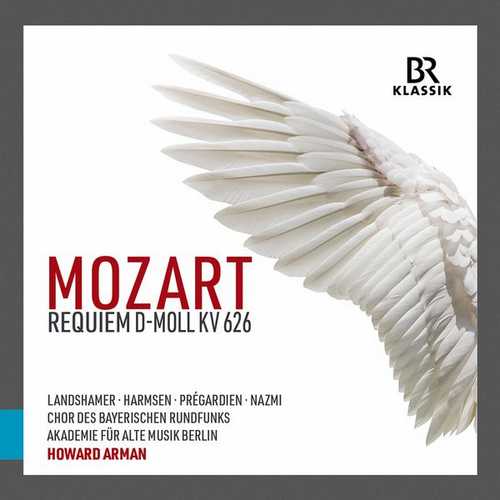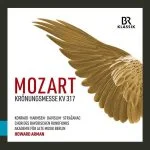

Composer: Howard Arman, Wolfgang Amadeus Mozart, Sigismund Neukomm
Performer: Raphael Alpermann, Nikolaus Pfannkuch, Christina Landshamer, Sophie Harmsen, Julian Pregardien, Tareq Nazmi, Christian Baumann, Howard Arman, Hans Jürgen Stockerl, Burchard Dabinnus, Katja Schild, Franziska Ball, Chor des Bayerischen Rundfunks
Orchestra: Akademie fur Alte Musik Berlin
Conductor: Howard Arman
Numbero of Dscs: 2
Format: FLAC (tracks)
Label: BR Klassik
Catalogue: 900926
Release: 2020
Size: 1.45 GB
Recovery: +3%
Scan: cover
CD 01
Mozart: Vesperae solennes de confessore
01. Antiphon. Ecce sacerdos magnus (Choral)
02. Dixit Dominus (Psalm 109). Allegro vivace
03. Antiphon. Ecce sacerdos magnus (Choral)
04. Antiphon. Non est inventus (Choral)
05. Confitebor (Psalm 110). Allegro
06. Antiphon. Non est inventus (Choral)
07. Antiphon. Ideo (Choral)
08. Beatus vir (Psalm 111). Allegro vivace
09. Antiphon. Ideo jurejurando (Choral)
10. Antiphon. Sacerdotes Dei (Choral)
11. Laudate pueri (Psalm 112)
12. Antiphon. Sacerdotes Dei (Choral)
13. Antiphon. Serve bone (Choral)
14. Laudate Dominum (Psalm 116). Andante ma un poco sostenuto
15. Antiphon. Serve bone et fidelis (Choral)
16. Antiphon. Dum esset summus pontifex (Choral)
17. Magnificat. Adagio – Allegro
18. Antiphon. Dum esset summus pontifex (Choral)
Mozart: Requiem für Soli, Chor, Orchester und Orgel in d-Moll, KV 626
Introitus
19. Requiem aeternam. Adagio
Kyrie
20. Kyrie eleison. Allegro
Sequenz
21. Dies irae. Allegro assai
22. Tuba mirum. Andante
23. Rex tremendae. Andante maestoso
24. Recordare. Allegretto
25. Confutatis. Andante
26. Lacrimosa. Andante moderato – Amen
Offertorium
27. Domine Jesu. Andante con moto
28. Hostias. Andante – Anddante con moto
29. Quam olim Abrahae
Sanctus
30. Sanctus. Adagio – Allegro
Benedictus
31. Benedictus. Andante – Allegro
Agnus Dei
32. Agnus Dei. Andante maestoso
Communio
33. Lux aeterna. Adagio – Allegro
Neukomm: Libera me, Domine für Chor und Orchester als liturgische Ergänzung zum Mozart-Requiem
34. Libera me, Domine
35. Tremens factus sum ego
36. Quando coeli movendi sunt
37. Dies illa
38. Requiem aeternam
39. Libera me, Domine
CD 02
Mozart: Requiem in d-Moll, KV 626
Eine Werkeinführung von Markus Vanhoefer
Teil 1: Tod und Verklärung 24:12
01. Eine neue Vervollständigung
02. Die tragische Tonart
03. Der graue Bote
04. Der wahre Endzweck unseres Lebens
05. Dokument des Verschwindens
Teil 2: Lückenfüller
06. Anonymus
07. Das Fragment
08. Klangfarben als Symbol
09. „Remplissage“
10. Herausforderung „Fuge“
11. Berufliche Perspektiven
Teil 3: Mythos und Manuskript
12. Süßmayr
13. Eybler
14. Urschrift und Erstdruck
15. Der Requiemstreit
16. „Libera me“
The version submitted by Howard Arman for the Bavarian Radio Chorus is based on surviving Mozart sources as well as on Süßmayr’s additions. Mozart’s Requiem is followed by Neukomm’s Respond Libera me, Domine – and for musical, liturgical and chronological reasons, the programme begins with Mozart’s Vesperae solennes de Confessore KV 339 (1780), composed of psalms from the Old Testament as well as the Magnificat from the Gospel of St Luke and composed for the liturgical festival of a holy confessor. Howard Arman has prepended Mozart’s movements for the festival vespers with antiphons taken from the vespers De Confessore Pontifici (for a confessor who was a bishop) of the Gregorian Liber usualis, and has also composed his own organ intonations to enhance the antiphons. Although it remained incomplete as Mozart’s last work, the Requiem in D minor (1791) ranks as one of the most important settings of the Latin Mass for the Dead ever written. Immediately after Mozart’s all too premature death, his pupil Franz Xaver Süßmayr elaborated a completed version that is still appreciated and regularly performed to this day because of its close proximity to the original – and this despite a number of new adaptations created over the years that sometimes add cautious improvements to the Süßmayr version or instead follow their own lights entirely.



